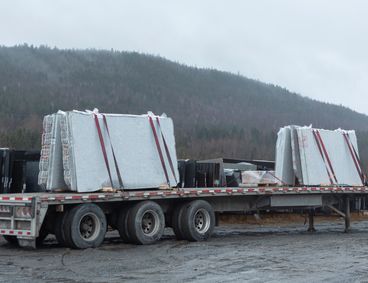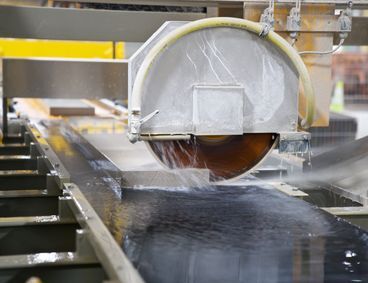How we make it greener Limestone Facades, Cladding & Walls
Natural stone quarrying process has high yields and little excess material because the stone is close to surface. It's different from metal mining, where large amounts of earth must be removed to extract very little quantities. Also, underground quarrying, which has been perfected for generations at our Eureka Quarry, reduces land use and is a practice that Polycor wishes to extend to several quarries.
In addition, few consumables are needed to extract natural stone. Contrast that with other building materials, Polycor specifically focuses on sourcing the highest grades of natural stone so that, for instance, a black granite stone, doesn’t need dyes to achieve its rich color.
From the bedrock to the point of sale, Polycor maintains an unbroken ownership of the supply chain allowing it to maintain standards of quality and practice.

Using stone from local sources is the single biggest opportunity to reduce its embodied carbon. Since natural stone is a heavy material, the environmental impacts for transporting it end up being one of its most significant source of carbon. Natural stone is sourced world-wide and each deposit has unique aesthetic and performance characteristics so this is not always avoidable. Be sure to understand the distances between the quarry, the processing facility, sometimes the distribution centers but also the transportation mode. In most of Polycor's operations, the quarry is within miles of the processing facility.

Manufacturing natural stone is so simple that you can sumarize it by a single action, cutting. Cutting large piece into smaller pieces ending in a finished product. Also, the beauty of natural stone products is that there is no chemical mixed within our products. Therefore, they are inherently a non-emitting source of VOCs.
Recycling water is reused several times into the manufacturing process and is compulsory to achieve ANSI 373 Standard.
There are a large variety of sizes and finishes that are commonly used for natural stone. Design teams can help reducing energy consumption in the following ways: Usage of low embodied carbon finishes such as water jet, 3D analysis to loose as few stone as possible troughout it's transformation, accepting the natural variation in the material so there is more usable material.

Whether you think of the Egyptian pyramids, the Colosseum of Rome, the cathedrals of the European capitals or closer to us; the famous Empire State building; natural stone is the most durable, classic and timeless building material on Earth. With 100+ years of durability, natural stone lasts longer than other building construction material and projects that use natural stone require less maintenance.
Since we don't use any chemicals, natural stone products as well as excess process materials throughout the extraction and transformation phases can be reused or recycled into gravel for roads, landscaping products and even furniture and jewelry. In short, natural stone can be reused and recycled multiple times during its life cycle; the only limit is your imagination!
Nevertheless, even if natural stone ends up in a construction landfill, there will be no toxic chemicals seeping into the earth as the material degrades. It simply returns to the earth, cradle to cradle.

 SM Transparency Report (EPD)
SM Transparency Report (EPD) 
